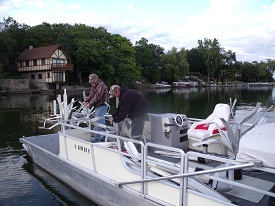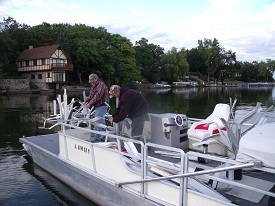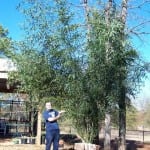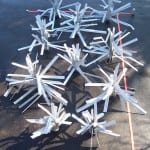
Photo by Jerry Jourdan
Trenton, Mich. – Much like the television program called “Extreme Makeover” that showcases efforts to renovate houses and makeover people to achieve remarkable results, an industrial brownfield in Trenton, Mich. is undergoing an extreme makeover into the gateway to North America’s only international wildlife refuge.
For 44 years, beginning in 1946, automobile component manufacturing occurred on this 44-acre tract of waterfront property in Trenton, Mich. This facility was remediated to industrial standards, closed, and sat vacant as an industrial brownfield for 12 years starting in 1990. Then in 2002, it was purchased by Wayne County to become the gateway to the Detroit River International Wildlife Refuge. This property is now known as the Refuge Gateway.
A master plan for the Refuge Gateway was then developed by Wayne County, the U.S. Fish and Wildlife Service, and many partners to serve as a blueprint for the cleanup and restoration work at the Refuge Gateway necessary to establish the site as an ecological buffer for Humbug Marsh, now Michigan’s only “Wetland of International Importance” designated under the international Ramsar Convention.
The Refuge Gateway will also become the future home of the Refuge’s visitor center. Everything people will see and do at the Refuge Gateway will teach them conservation and how to live sustainably. Since the completion of the master plan, much work has been accomplished, including: cleanup and capping brownfield lands; daylighting Monguagon Creek and constructing a retention pond and emergent wetland to treat storm water prior to discharge to the Detroit River; completion of a first access road that brings visitors into the Refuge Gateway and adjacent Humbug Marsh; and the development of trails and an education shelter in Humbug Marsh for visitor’s to experience our great outdoors. In fall 2011, the Shoreline Restoration Project was completed at the Refuge Gateway that included restoring a natural shoreline, removal of human-placed fill and debris to restore over three acres of riparian buffer habitat, and construction of a second access road and kayak landing. These projects have resulted in an “Extreme Makeover” of the Refuge Gateway landscape. Now, this former industrial site includes wildlife habitat, innovative storm water management practices, opportunities for outdoor recreation and environmental education, and one of the most exceptional views of the Detroit River.
Also announced today was $1.39 million in new funding to complete all cleanup and restoration work in 2012 necessary for future construction of the Refuge’s visitor center. A capital campaign is underway to raise money for construction of the Refuge’s visitor center.
The funding for completion of all cleanup and restoration work at the Refuge Gateway comes from the National Fish and Wildlife Foundation ($500,000), U.S. Environmental Protection Agency’s Brownfield Cleanup Program through Downriver Community Conference’s Brownfield Consortium ($750,000), and the U.S. Forest Service ($113,700). With this funding, the overall project will realize goals of achieving a net gain of 16 acres of coastal wetlands, restoring 25 acres of upland buffer habitat at the Refuge Gateway, treating invasive Phragmites along 2.5 miles of shoreline, and control of invasive species on 50 acres of upland habitats in Humbug Marsh and the Refuge Gateway. In an area that has lost 97% of historic coastal wetland habitat, these accomplishments are significant for conservation of fish and wildlife habitat, and for protection of our Detroit River that provides world-class outdoor recreational opportunities.
“The work being done at the Refuge Gateway is a wonderful story to be told,” notes Congressman John D. Dingell. “Right in the middle of a populated urban area, we are taking the site of an old and abandoned automotive manufacturing facility, cleaning it up, and restoring it to its natural wonder to provide habitat for thousands of plant and animal species. I remember hunting in Humbug Marsh with my dear old dad when I was a kid and promised it would be my life’s mission to make sure these types of opportunities exist for the generations to come. By cleaning this site up, we are paving the way to build a beautiful visitor center and allow the nearly seven million residents in the area to experience and learn about the importance of the almost 6,000 acres of North America’s only international wildlife refuge. Without the support of our public and private partners, especially the U.S. Environmental Protection Agency, this work would not be happening. Everyone should be proud of their contributions to the work that has been done and continues to be done at the Refuge.”
“U.S. EPA is proud to support this ambitious environmental restoration project,” said EPA Regional Administrator Susan Hedman. “The Agency has committed a total of $1.2 million to help transform this abandoned industrial site into a refuge that will provide high quality habitat for wildlife and opportunities for people to enjoy the outdoors and learn about nature.”
“This Refuge Gateway project can best be described as transformational for our region,” notes Paula Boase, Director of Economic Development at Downriver Community Conference. “This project is literally transforming an industrial brownfield into the gateway to our international wildlife refuge, showcasing southeast Michigan as an international leader in sustainable redevelopment and conservation, helping attract and retain employees for our businesses, and enhancing quality of life.”
The Detroit International Wildlife Refuge covers 48 miles of shoreline along the lower Detroit River and western basin of Lake Erie. It stretches from southwest Detroit to the Ohio-Michigan border. The Refuge focuses on conserving, protecting and restoring habitat for 300 species of birds, including 30 species of waterfowl, 23 species of raptors, and 31 species of shorebirds, and for 117 species of fish.
Humbug Marsh is located on the lower end of the Detroit River in the cities of Trenton and Gibraltar. It represents a significant portion of the last unaltered U.S. wetlands in the Detroit River and the last mile of natural shoreline on the river’s U.S. mainland. Humbug is a unit of the Detroit River International Wildlife Refuge. The marsh serves as a vital habitat for 51 species of fish, 90 species of plants, 154 species of birds, seven species of reptiles and amphibians, and 37 species of dragonflies and damselflies.
For more information, please contact John Hartig of the U.S. Fish and Wildlife Service (734-692-7608;john_hartig@fws.gov) or Allison Krueger of the Detroit River International Wildlife Refuge (734-692-7672;krueger.ali@gmail.com).
For more information on the Midwest Region of the U.S. Fish and Wildlife Service visit http://midwest.fws.gov.
See the dozens of unique artificial fish habitat models, fish attractors and fish cover used at fishiding.com, the industry leader and only science based, man made and artificial fish habitat, proven to provide all fish with cover they prefer to prosper.
The mission of the U.S. Fish and Wildlife Service is working with others to conserve, protect and enhance fish, wildlife, plants and their habitats for the continuing benefit of the American people. We are both a leader and trusted partner in fish and wildlife conservation, known for our scientific excellence, stewardship of lands and natural resources, dedicated professionals and commitment to public service. For more information on our work and the people who make it happen, visit www.fws.gov.








 By redirecting Kama Creek to its original formation, it is hoped fish like Brook Trout will repopulate the area. (Lakehead University)After studying the area extensively, Stewart said researchers were confident the creek could be restored to a condition resembling its original pre-1960s configuration.
By redirecting Kama Creek to its original formation, it is hoped fish like Brook Trout will repopulate the area. (Lakehead University)After studying the area extensively, Stewart said researchers were confident the creek could be restored to a condition resembling its original pre-1960s configuration. Graduate students are expected to take part in the ongoing monitoring of Kama Creek. (Lakehead University)He said he expects that future graduate students will carry out post-monitoring for the Kama restoration.
Graduate students are expected to take part in the ongoing monitoring of Kama Creek. (Lakehead University)He said he expects that future graduate students will carry out post-monitoring for the Kama restoration.
